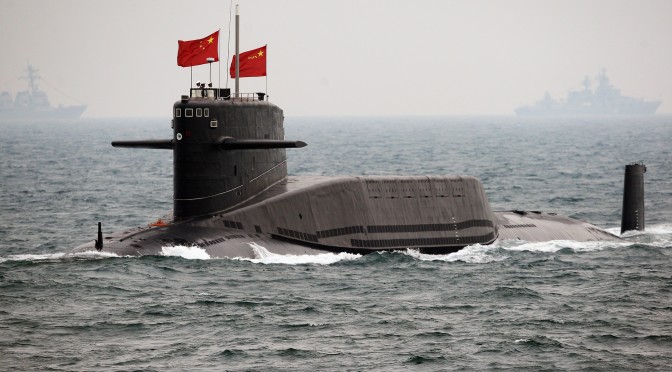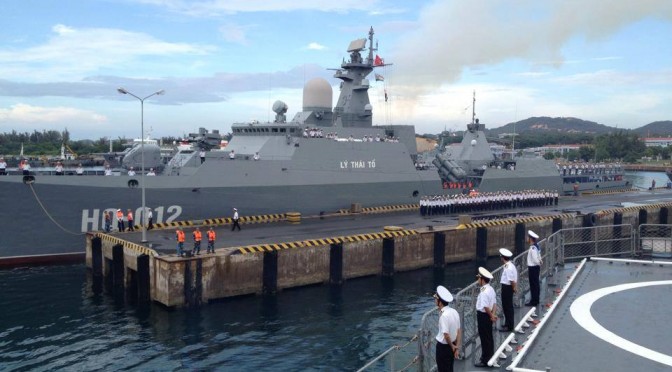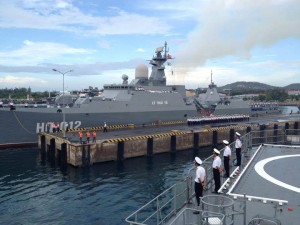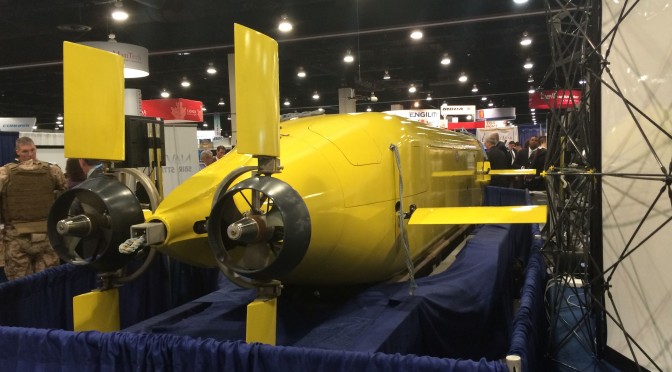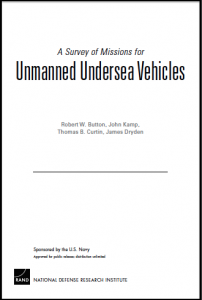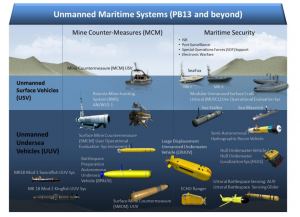The new 2015 Maritime Strategy demands a significant part of the Navy be forward based or operated in order to achieve national goals. The current number of ships and their present deployment pattern may not support the new strategy’s goals. Several recent articles have bemoaned the Navy’s shrinking surface ship fleet, or sought to make light of the overall number of ships as a significant determinant of strategic naval power. Both are, in a way, incorrect. The number of ships does matter, but wishing for a return of the halcyon 1980’s and the 600 ship navy is a futile hope in the face of the present budget deficit and growing welfare state. The post World War 2 U.S. Navy deployment structure has been based on the maintenance of a specific number of total ships in order to maintain a consistent overseas naval peacetime presence and credible war fighting force if required. The solution to this combination of forward deployment requirements on a limited budget is a fundamental change to the post-1948 U.S. naval deployment scheme through a global redistribution of U.S. naval assets. Potential threats, strategic geography, and support from potential coalition partners should govern this effort. The Navy should also seek new technologies to reduce overall budget costs. If this sounds familiar, it is not a new concept. Great Britain’s Royal Navy, under the leadership of the fiery transformationalist Admiral Sir John Fisher, executed a similar successful change just over a century ago in a similarly bleak financial environment. A modified version of Fisher’s scheme represents the U.S. Navy’s best hope to assign relevant naval combat power where it is most needed and at the best cost.
Britain’s Successful Rebalance
Like the U.S. today, Great Britain at the turn of the last century was a nation in rapid relative decline. British industry and its share of the world economy were shrinking in response to the rise of Germany, Japan, and the United States. The navies of those nations, as well as traditional enemies like France and Russia were growing in size and capability. Great Britain had just concluded the financially taxing and internationally embarrassing Boer War, which strained the nation’s tax base and earned it international opprobrium for harsh treatment of Boer combatants and civilians. The concept of a British Welfare state had gained significant support, and expenditures for this new government responsibility threatened the budgets of the Army and the Navy; both of which required significant modernization.
Admiral Fisher was selected by the Conservative Party’s First Lord of the Admiralty, Lord Selborne, specifically for his daring pledge to cut naval spending, while increasing the power and overall capability of the Royal Navy (RN). Fisher scrapped large numbers of older warships; created a ready reserve of minimum manned, older, but still capable combatants; reformed the RN’s personnel structure; and argued for the adoption of revolutionary technologies such as turbine engines, oil fuel for ships, director-based gun firing, submarines, and naval aircraft. A succession of Navy civilian leaders from both of the large British political parties supported his efforts. Most importantly, Fisher presided over the biggest re-balancing of British naval assets since the end of the Napoleonic wars. Before Fisher the RN was divided amongst various colonial stations around the world. Its most significant operational commands were the Atlantic and the Mediterranean Fleets that protected Britain’s line of communication to India via the Suez Canal. Although Fisher’s initial strategy was to counter France and Russia, the concentration of British naval strength in home waters allowed it to counter rising German threats. Britain sought simultaneous colonial agreements with France and Russia to reduce tension, and signed an official alliance with the emerging Japanese Empire to secure communications with its Pacific possessions. It also unofficially acquiesced to U.S. naval domination in the Western Hemisphere to eliminate any tensions with the other great English-speaking nation. All told, these efforts allowed Fisher to keep British naval spending at 1905 levels until 1911.1 They also ensured that a significant British naval force was in place for war with Germany in 1914.
Conditions for U.S. Rebalance
The U.S. would be well served to create a global re-balance program along the lines of Admiral Fisher’s for its own Navy. In reverse of Fisher, however, the bulk of America’s naval strength must move from bases in home waters to the periphery of the nation’s interests. Some reductions in overall naval strength will be required to ensure that forward forces are well trained and equipped for both peacetime presence and wartime combat functions. Assignment will depend on regional geography, threat level and the availability of coalition partners to augment, or in some case replace U.S. naval assets.
The large deck nuclear aircraft carrier and its associated air wing are best employed in locations where land-based aviation assets are vulnerable or scarce due to geographic location. For this reason, the bulk of the carrier force should be assigned to distributed bases in the Indo-Pacific region. A force of six large carriers would serve as the core of the Pacific naval component. The surface combatant and attack submarine force based in the Pacific would be a commensurate percentage of its overall strength. They should be sufficient in number to support carrier escort, independent operations, and surface action groups as recommended for the emerging strategy of distributive lethality. This force would be large enough to conduct meaningful fleet and large scale joint exercises in a number of warfighting disciplines.
The carrier’s assignment to the largest ocean area of responsibility (AOR) best supports a joint commander’s warfighting requirements in a predominately maritime environment. The caveat with the assignment of carriers geographically is that the post-1948 deployment pattern of ‘three aircraft carriers equal one forward deployed, active carrier’ must be scrapped. This means retiring two carriers, perhaps the two oldest Nimitz class when the USS Gerald R. Ford is commissioned in next year. One carrier strike group costs $6.5 million dollars a day to operate.2 The funds saved in the retirement of two carriers could be directed toward the maintenance of and operational costs of the remaining eight, with the proviso that these be consistently ready for service as required.
The Eurasian littoral areas historically supported by east coast naval forces would receive smaller, tailored force packages in this new organization scheme. Given that Eurasian littoral operations can be supported by land-based air units, only two carriers need be assigned to the Atlantic coast with perhaps a third designated as a training carrier.
A Substitute for a Carrier Strike Group
Under this arrangement the Mediterranean and Persian Gulf areas would not see regularly deployed large deck carriers. To offset their absence, it is proposed that two light carrier groups be forward-based on the Mediterranean and Indian Ocean respectively. Such a group would each be centered on an LHA-6 class amphibious warship configured as a light carrier with an airwing of 20+ F-35 Lightning II strike aircraft. The CVL-configured LHA, too small to support the full traditional carrier wing of both attack and support aircraft, would be supported by land-based assets that would provide airborne early warning (AEW), tanking, and other strike missions. Each group would contain three DDG-51 class destroyers for offensive and defensive roles including missile defense, a DDG-1000 class destroyer for surface strike and other warfare roles, and a flotilla of four to six littoral combat ships (LCS) or similar frigates (FF’s) for a variety of low intensity combat and surface strike missions. Attack submarines may be included as needed and an amphibious warfare group similar to the present 7th fleet formation based in Sasebo, Japan round out the numerical assignments. A full amphibious ready group (ARG) with associated Marine Expeditionary Force (MEU) based at Rota could exploit NATO/EU capabilities in the region as well. Most of these rebalancing efforts can be completed between 2020 and 2025, with the fight light carrier group ready by 2017. It may begin operations with the AV-8B II Harrier, but later transition to the F-35B Lightning II. After 2020, an international carrier strike group (CSG) presence might be maintained in the Eastern Mediterranean with British, French, Italian, and Spanish carriers playing a role.3
The Mediterranean offers a number of ports that together are capable of hosting such a force including Rota, Spain, Sigonella, Sicily, and Souda Bay, Crete. The Western Pacific/Indian Ocean represents a more complicated basing picture, but a combination of facilities in Singapore, Darwin, and Perth, with a forward anchorage in Diego Garcia might offer sufficient space to support to forward deployed forces. Both regions offer a number of land-based aviation facilities to support a light carrier formation.
The navies of friends and formal allies offer additional support to this strategy. The U.S. has consistently sought and depended on coalition allies in the conflicts it has engaged in since 1945, and especially since 1990. European fleets have changed from antisubmarine Cold War forces to smaller, but more deployable, larger combatants capable of global operations. Resident European force in the Mediterranean and deployed forces in the Persian Gulf region might augment U.S. efforts in those regions. The Libyan Operation of 2011 (Operation Odyssey Dawn for the U.S.), showcased what a U.S. light carrier group, as centered then on USS Kearsarge, and European forces might accomplish. The British Defence Secretary’s recent announcement that the Royal Navy will develop a base in Bahrain suggests that at least British and perhaps other Commonwealth nations’ navies might support U.S. efforts in the Persian Gulf region.
Options for Cooperation and Technological Offset
Strong U.S. relationships with Western Pacific nations are essential to any re-balancing strategy in that region. The adoption of AEGIS systems by the Japanese Maritime Self Defense Force, the South Korean, and Australian navies significantly aids in cooperative efforts. Close U.S. ties with Singapore, the Philippines, and other regional naval forces are also essential to U.S. efforts. One method of achieving this might be a Western Pacific version of the Standing NATO Maritime Groups. An international squadron with rotating command responsibilities would be useful in easing old tensions and promoting better relations amongst this diverse group of nations.
The “long pole in the tent” of such a re-balancing strategy is how to manage the personnel disruptions such a change would cause. The CONUS-based U.S. deployment strategy, and dependent housing agreements in Japan and some Mediterranean nations has allowed for a great deal of family stability. Sailors can remain reasonably close to their families, even when forward deployed. There is no guarantee that Pacific or Mediterranean nations would accept large increases in the population of U.S. naval personnel and their dependents resident within their borders. In addition to the foreign relation concerns, such additions would cost a considerable amount of money and involve greater security risks in protecting a larger overseas American service and dependent population. The answer to this problem is to ‘dust off’ some of the reduced and creative manning projects of the last decade. While not ideal in many ways, reduced manning, crew swaps, and longer, unaccompanied deployments may become the norm, rather than the exception for American sailors.
Unfortunately, this is the price of putting more credible combat power in forward areas at present or even reduced costs. The U.S. will be hard-pressed to duplicate Admiral Fisher’s other revolutionary changes. The U.S. Navy has retired nearly all of its outdated warships, and further reductions of newer platforms will harm overall naval capabilities. Revolutionary changes in armament such as the rail gun and other directed energy weapons, and continued advances in the electric drive concept may allow for some cost reductions in naval expenditures, but they remain far from mature development. The rail gun is slated for additional afloat testing, but with a barrel life of only 400 rounds, it represents a 21st century equivalent of the arquebus.4 Fisher, by contrast, had relatively mature technological solutions in propulsion, and rushed fire control, aircraft, and submarine advances into full production with mixed results. The present U.S. test and evaluation culture would not permit such bold experimentation.
The U.S. can, however, improve its overall forward naval posture by re-balancing its force structure along geographic lines to better support national interests and regional commanders’ requirements. Additional force structure will be difficult to achieve in the face of present budget woes. Transformational technology is moving toward initial capabilities, but is not yet ready for immediate, cost savings application. The post-1948 CONUS-based deployment system is becoming more difficult to maintain with fewer ships and persistent commitments. Despite these dilemmas, the U.S. must fundamentally change the deployment and basing structure of the fleet in order to provide credible combat power forward in support of joint commander requirements. The new 2015 Maritime Strategy will not achieve many of its goals using the present CONUS-based deployment construct. Geographic re-balance of the fleet will provide strength were it is most needed.
1. A detailed explanation of the Fisher/Selborne re-balance strategy may be found in Aaron Friedberg’s The Weary Titan, Britain and the Experience of Relative Decline, 1895-1905, pages 135-208.
2. Captain Jerry Hendrix, USN (ret), PhD, “At What Cost a Carrier”, Center for New American Security (CNAS), March 2013, p. 7.
3. Conversation with retired NSWCCD Senior Warfare Analyst James O’Brasky.
4. 15 February statement of Statement of Rear Admiral Mattew L. Klunder, USN, Chief Of Naval Research before the Intelligence, Emerging Threats and Capabilities Subcommittee of the House Armed Services Committee on the Fiscal Year 2015 Budget Request, 26 March, 2014.


